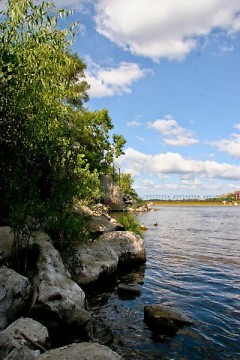The city of Grand Rapids was named for the Grand River’s once-iconic whitewater rapids, which have been conspicuously absent for decades. Now, plans are trickling forward to restore the Grand River’s whitewater. The idea came about through the efforts of Grand Rapids WhiteWater and the City’s Green Grand Rapids Master plan, which was adopted in November 2011.
Two years later, Grand Rapids WhiteWater released the preliminary Grand River Restoration Plan, which aimed to remove dams, reintroduce boulder rapids below the sixth Street dam, and construct a sea lamprey barrier.
The restoration project represents a significant enterprise—but the effort is not merely for the city’s name’s sake. Reintroducing the rapids is projected to restore lake sturgeon and other native fish spawning grounds, improve local recreation opportunities, and encourage cash flow from recreation tourism as visitors stream to the city for kayaking and fishing excursions. If the river flows freely, the argument goes, so will the tourism dollars.
The economic benefits were documented in the 2014 Grand Rapids WhiteWater Economic Impact Study, which projects that restoring the rapids will produce a net economic result of between $15.9 million and $19.1 million annually.
“Grand Rapids is a very vibrant city; it’s got a lot going for it,” said Todd Ambs, the campaign director of Healing Our Waters—Great Lakes Coalition. “Being able to fully restore the downtown portion of the Grand River could really be a catalyst for a lot more exciting activities downtown.” The Coalition and the Brookings Institute found in 2007 that every dollar invested in restoration of the Great Lakes region resulted in at least twice that in economic returns. Other communities across the country, Ambs said, have “seen some real economic benefits that flow from the environmental improvement.”
Aspects of River Restoration have been incorporated into the GR Forward Initiative. Started in April 2014, the Initiative seeks to reimagine, alter, and ultimately improve the river in terms of its flood resilience, native species habitat, and opportunities for human recreation. The plan encompasses the surrounding neighborhoods and proposes green spaces as well, with the intention of revitalizing riverfront communities as well as the river.
Perhaps the most significant hurdle for the plan’s implementation is the city’s bipartite quest for funding and permitting—the project’s scope is significant, spanning the river corridor from Lamoreaux to Millennium Parks. Ambs expects the funding will come through, particularly since the results of comparable projects across the country have been positive.
“Having it designated as an urban water priority by the Federal Government has certainly opened some doors,” Ambs said. “I’m pretty optimistic they’ll be able to find the funding that’s necessary to do the project, especially when you look at similar efforts in other places and the successes that those have had.”
The second half, the city’s search for permitting, is likewise flowing apace. “The Grand River Revitalization and Rapids Restoration project is actively engaged with state and federal agencies in one of the longest phases of the permitting process, the pre-application phase” said Jay Steffen, City of Grand Rapids assistant planning director.
“Grand Rapids WhiteWater has been doing a lot of the preliminary design work,” said Rachel Hood, Executive Director of West Michigan Environmental Action Council. “And then you begin to take that to different funders and regulatory agencies, and you begin to take input, and the conversation continues to happen until everyone feels comfortable with the design and project timeline, at which point they submit actual applications. Right now we’re in that dance.”
The Rapidian, a program of the 501(c)3 nonprofit Community Media Center, relies on the community’s support to help cover the cost of training reporters and publishing content.
We need your help.
If each of our readers and content creators who values this community platform help support its creation and maintenance, The Rapidian can continue to educate and facilitate a conversation around issues for years to come.
Please support The Rapidian and make a contribution today.

